M109 howitzer
The M109 is an American 155 mm turreted self-propelled howitzer, first introduced in the early 1960s to replace the M44. It has been upgraded a number of times, most recently to the M109A7. The M109 family is the most common Western indirect-fire support weapon of maneuver brigades of armored and mechanized infantry divisions.
| M109 | |
|---|---|
 M109A6 | |
| Type | Self-propelled artillery |
| Place of origin | United States |
| Service history | |
| In service | M109: 1963–present M109A1: 1970–present M109A2: 1979–present M109A6: 1994–present M109A7: 2015–present |
| Wars | Vietnam War Cambodian Civil War Yom Kippur War Iran–Iraq War 1982 Lebanon war Western Sahara War Persian Gulf War Iraq War 2014 Israel–Gaza conflict War in Iraq (2013-2017)[1] Yemeni Civil War (2015–present), Saudi Arabian-led intervention in Yemen Syrian Civil War 2022 Russian invasion of Ukraine |
| Production history | |
| Designed | 1952–1962 |
| Manufacturer | Cadillac General Motors Chrysler BMY Harsco (1974–1994) United Defense (1994–2005) BAE Systems Inc. (2005–present) Samsung (1985–2015) Hanwha (2015–present) |
| Specifications | |
| Mass | 27.5 tons M109A7: 84,000 lb (38.1 t) |
| Length | 30 ft (9.1 m) |
| Width | 10 ft 4 in (3.15 m) |
| Height | 10 ft 8 in (3.25 m) |
| Crew | 6 (commander, driver, gunner, 3 loaders) M109A6–A7: 4 (commander, driver, gunner, loader) |
| Shell | separate loading, bagged charge |
| Breech | interrupted screw |
| Traverse | 360° |
| Rate of fire | Maximum: 4 rpm/3 min.[2] Sustained: 1 rpm[2] |
| Effective firing range | M109A1–A4: 18.1 km (11.2 mi) (M107, HE) 23.5 km (14.6 mi) (M549A1, RAP/HE) M109A5–A7: HE: 21 km (13 mi) RAP: 30 km (19 mi) Excalibur: 40 km (25 mi)[3] |
| Armor | Aluminum alloy |
Main armament | M109: M126 155 mm 23 caliber, 28 rounds M109A1–A4: Watervliet Arsenal M185 155 mm 39 caliber, 28 rounds (A1) or 36 rounds (A2–A4) M109A5–A7: M284 155 mm 39 caliber[4] |
Secondary armament | .50 caliber (12.7 mm) M2 machine gun |
| Engine | M109: Detroit Diesel 8V71T 8-cylinder water-cooled supercharged diesel engine 345 hp @ 2.300 rpm, 14.5 hp/t M109A1–A4: Detroit Diesel 8V71T 8-cylinder water-cooled supercharged diesel engine 405 hp @ 2.300 rpm, 16.9 hp/t M109A5–A6: Detroit Diesel 8V71T 8-cylinder water-cooled supercharged diesel engine 440 hp M109A7: V903 675 hp |
| Transmission | Allison Transmission XTG-411-2A, 4 forward, 2 reverse M109A6: Allison Transmission XTG-411-4 M109A7: HMPT-800 |
| Suspension | torsion bar |
| Ground clearance | M109A7: longitudinal slope: 60 % lateral slope: 40 % trench: 72 in (1.8 m) fording: 42 in (1.07 m) |
Operational range | 216 mi (350 km) M109A7: 186 mi (300 km) |
| Maximum speed | 35 mph (56 km/h) M109A7: 38 mph (61 km/h) |
The M109 has a crew of four: the section chief/commander, the driver, the gunner, and the ammunition handler/loader. The chief or gunner aims the cannon left or right (deflection) and up and down (quadrant).
The British Army replaced its M109s with the AS-90. Several European armed forces have or are currently replacing older M109s with the German PzH 2000. Upgrades to the M109 were introduced by the U.S. (see variants) and by Switzerland (KAWEST). With the cancellation of the U.S. Crusader and Non-Line-of-Sight Cannon, the M109A6 ("Paladin") will likely remain the principal self-propelled howitzer for the U.S. until the new M1299 enters service.
Operational history

The M109 was the medium variant of a U.S. program to adopt a common chassis for its self-propelled artillery units. The light version, the M108 Howitzer, was phased out during the Vietnam War, but many were rebuilt as M109s.
The M109 saw its combat debut in Vietnam. Around 200 vehicles were deployed in 1966, but the entire fleet suffered a mechanical malfunction within a year of operation. The U.S. dispatched engineers and mechanics, but all M109s were recalled back to the U.S. in 1967 after failing to repair on the field. The howitzer underwent upgrades afterward, which resulted M109A1 variant that went into production in 1970.[5]
Israel used the M109 against Egypt in the 1973 Yom Kippur War and in the 1982 and 2006 Lebanon Wars. Iran used the M109 in the Iran–Iraq War in the 1980s. The M109 saw service with the British, Egyptian and Saudi Arabian Armies in the 1991 Gulf War. The M109 also saw service with the U.S. Army in the Gulf War, as well as in the Iraq War from 2003 to 2011.
Upgrades to the cannon, ammunition, fire control, survivability, and other electronics systems over the design's lifespan have expanded the system's capabilities, including tactical nuclear projectiles, guided projectiles (Copperhead), Rocket Assisted Projectiles (RAP), FAmily of SCAtterable Mines (FASCAM), and cluster munitions (the Dual-Purpose Improved Conventional Munition, DPICM).
In August 2015, South Korean K55A1s fired rounds behind the Military Demarcation Line as a warning after several provocations.[6]
Design
The M109 was developed by the Ground System Division of United Defense LP (now BAE Systems Land and Armaments).[4]
Armament

- Primary by Watervliet Arsenal: M126 Cannon (or M126A1) 155 mm Howitzer (M109), M185 Cannon 155 mm Howitzer (A1/A2/A3/A4), or M284 Cannon 155 mm Howitzer (A5/A6)
- Secondary: .50 caliber (12.7 mm) M2 machine gun, Mk 19 Mod 3 40 mm Automatic Grenade Launcher, 7.62 mm M60, M240 machine gun or L4 machine gun
Hypervelocity Projectile (HVP)
In January 2016, the U.S. Army test-fired hypervelocity projectiles originally designed for use by U.S. Navy electromagnetic railguns and found that they significantly increased the gun's range. The Army is looking into using the M109 Paladin firing the HVP for ballistic missile defense, as traditional missile interceptors are expensive and gun-based missile defense used for point defense would use artillery at a much lower cost per round.[7][8] The HVP is capable of being fired out to 50 nautical miles (58 mi; 93 km) from a conventional cannon. It weighs 68 lb (31 kg) with a 46 lb (21 kg) flight body containing its guidance and warhead—less powerful, but more agile to hit small, high-speed targets. Modifications will be needed for the Paladin to effectively shoot the HVP, possibly including different propellant to achieve higher velocities, automated reloading systems to fire quickly enough to defeat salvo launches, improved barrel life, and a new fire control and sensor system.[9] During a test of the Air Force's Advanced Battle Management System (ABMS) on 3 September 2020, an HVP fired from an Army Paladin howitzer successfully intercepted a BQM-167 target drone simulating a cruise missile.[10][11]
Variants
M109

First produced in 1963. It had a 23 caliber 155 mm M126 Cannon in an M127 Mount, and carried 28 rounds of 155 mm ammunition. It was also armed with a .50cal M2HB machine gun with 500 rounds of ammunition. Easily identified by its short barrel and a double baffle muzzle brake with a large fume extractor just behind it. Maximum range of 14,600 meters.
M109A1
Replaced the M126 Cannon with a 39 caliber M185 Cannon, featuring a longer barrel while increasing maximum range to 18,100 meters.
M109A2
Incorporated 27 Reliability, Availability, and Maintainability (RAM) mid-life improvements. Most notably, the long barreled 155 mm M185 Cannon in the new M178 gun mount, ballistic protection for the panoramic telescope, counterbalanced travel lock, and the ability to mount the M140 bore sight alignment device. Stowage of 155mm rounds increased from 28 to 36 rounds; .50cal ammunition remained at 500 rounds. During M109A2 production, a slightly simplified version was also produced for export. This had minor internal changes and deleted the hull flotation feature. These were designated M109A1B.[12]
M109A3 and M109A3B
M109A1s and M109A1Bs rebuilt to M109A2 standard respectively. Some A3s feature three contact arm assemblies, while all A2s have five.
M109A4
M109A2s and M109A3s improved with Nuclear, Biological, and Chemical / Reliability, Availability, and Maintainability (NBC/RAM) improvements, including air purifiers, heaters, and Mission Oriented Protective Posture (MOPP) (protective) gear.
The traversing mechanism's clutch was hydraulic, as compared to the electric mechanism on previous M109s, and featured a manual override. The M109A4 also gained a second hydraulic filter. Also included is an improvement to the engine starting equipment, greatly improving the ability to start in an emergency.
Ammunition stowage remained the same as in previous models.
M109A5

Replaces the 155 mm M185 Cannon in an M178 Mount with a 39-caliber 155 mm M284 Cannon in an M182 Mount, giving the A5 a maximum range of 22,000 meters with unassisted projectiles and 30,000 meters with Rocket Assisted Projectile (RAP) rounds.[13] The vehicle can carry 36 complete rounds of ammunition and has a 440 hp engine instead of the standard 405 hp engine.
M109A5+
Various manufacturers have upgraded the fire control and other components of the M109A5. BAE Systems in York PA recently delivered 12 M109A5+ vehicles to Chile and 40 M109A5+ vehicles for Brazil.
M109A6 "Paladin"


Overall product improvement in the areas of survivability, RAM, and armament. This includes increased armor, a redesigned internal arrangement for safer ammunition and equipment storage, engine and suspension upgrades, and product improvement of the M284 Cannon and M182A1 Mount. The greatest difference is the integration of an inertial navigation system, sensors detecting the weapons' lay, automation, and an encrypted digital communication system, which utilizes computer controlled frequency hopping to avoid enemy electronic warfare and allow the howitzer to send grid location and altitude to the battery Fire Direction Center (FDC) . The battery FDCs in turn coordinate fires through a battalion or higher FDC. This allows the Paladin to halt from the move and fire within 30 seconds with an accuracy equivalent to the previous models when properly emplaced, laid, and safed—a process that required several minutes under the best of circumstances. Tactically, this improves the system's survivability by allowing the battery to operate dispersed by pairs across the countryside and allowing the howitzer to quickly displace between salvos, or if attacked by indirect fire, aircraft, or ground forces.
Ammunition storage increased from 36 to 39 155 mm rounds.
The US Army received first Paladin in 1994 and last of 950 in 1999.
M109 "KAWEST"

This Swiss improved version produced by Ruag incorporates a new Swiss-designed L47 155 mm gun with an increased firing range of up to 36 km. It features inertial navigation system coupled with a new gun-laying system and more ammunition storage (40 rounds, 64 charges). The KAWEST (lit. Kampfwertsteigerung = upgrade of combat capabilities) requires only six crew members instead of eight, and is able to fire three-round bursts within 15 seconds or maintain a constant firing rate of over one round per minute.[14][15]
Upgraded Swiss PzHb (Panzerhaubitze) 79 and 88 (M109A1) are known as respectively PzHb 79/95 and PzHb 88/95.
M109L52
Jointly developed by the Dutch firm RDM and the German firm Rheinmetall, the M109L52 was first revealed in 2002. The main improvement was replacing the M126 series gun with the longer 52-caliber cannon from the PzH 2000, thus the MTLS ammunition of the PzH 2000 can be used. In addition, improvements to the loading system were made. This resulted in an increase of the rate of fire to 9–10 rds/min from the original 3 rds/min, and this high rate of fire can be sustained for up to 2 minutes. A total of 35 rounds can be carried.
M109A3GNM
The latest version in service with the Norwegian Army's Artilleribataljonen. 126 M109Gs were acquired from West Germany between 1969 and 1971. They were then upgraded to the M109A3GN configuration during the latter half of the 1980s. In 2006, there were still 56 M109A3GNs in the Army's inventory, meaning that at least 70 SPGs had been scrapped after the end of the Cold War. 14 of the M109A3GNs received additional upgrades in 2007, and were designated M109A3GNM. The upgrade includes, among other things, new intercom and new navigation and positioning systems. In 2020, both the 14 units with "A3GNM" upgrades and the rest of the units still having "A3GN" specs were put in storage, as all of the new Korean K9 Thunder units had been delivered.[16] In May 2022, Norway donated 22 "A3GN" to Ukraine.[17]
K55
K55 is a South Korean license produced variant of the M109A2. In the 1960s, the South Korean Army received M107 and M110 from the United States. However, the number of these self-propelled guns was insufficient to counter rapidly-growing North Korean artillery capabilities. In the 1970s, South Korea began mass-producing towed howitzers locally, but intelligence reports of North Korean 170 mm self-propelled artillery forced South Korea to look for a new self-propelled artillery system.[5]
In December 1983, the ministers of defense of the United States and South Korea signed a MOU to co-produce M109A2 in South Korea using American technical data. The United States delivered two completed M109A2s to South Korea for operational review, and the Agency for Defense Development began to translate the data package and created field and maintenance manuals for soldiers. South Korea wanted to produce every parts of the vehicle domestically; however, due to the amendment bill by Rep. Samuel S. Stratton of New York, which set the limit in foreign military technology cooperation, the turret and the M185 cannon from Watervliet Arsenal were imported from the United States.[5]
Compared to the M109A2, besides 63 percent of parts being produced locally, K55 has a driver's night periscope and light exposure minimization device to enhance night-time operations as well as additional radio systems. The vehicle also has NBC protection system, and halon fire extinguishers. A total of 1,180 K55s were produced between 1985 to 1996.[5][18] The vehicle's name was changed from KM109A2 to K55, which was originally a code name from the Samsung factory.
On 13 November 1990, the United States and South Korea signed an agreement to allow South Korea to supply M109 parts to third parties.[19] On 28 May 1997, during the Security Cooperation Committee held in Washington D.C., South Korea requested the United States to revise the MOU for the exporting whole K55, which are intended for domestic use only. South Korea was expecting to export 72 K55s and four ammunition support vehicles to Brazil for $160 million over Belgium's offer, but the United States Department of Defense declined the request to avoid an arms race in the region.[20][21]
On 29 May 1998, South Korean military began fielding K55 simulator to boost artillerymen training. The simulator took a year and a billion KRW budget for development, and is expected to save 150 million KRW per year per device.[22]
K55A1
The K55A1 is a South Korean overhaul and modernization of the K55 by augmenting the proven systems of the K9 Thunder and the K9 upgrade plan. The development took three years between 2007 to 2010, and the upgrade started in 2010.[5] On 30 November 2010, in the wake of the North Korean artillery attack, the South Korean government authorized massive increase of military spending; South Korea allocated 11.5 billion KRW on K55A1 upgrade for FY2011, more than a 1500% increase from 700 million KRW for FY2010.[23] The upgrade is performed by Samsung Techwin, and the first vehicle was fielded by the South Korean Army in early 2011.[24]
The K55A1 is fitted with the same electronics and fire control system as the K9. The self-propelled gun has significantly enhanced field operability and accuracy by the installation of Honeywell Aerospace's TALIN 5000 INS (inertial navigation system), satellite navigation device (GPS), and speed calibrator. As a result, the vehicle automatically lays the gun in the desired direction and delivers a first round within 45 seconds when stationary or 75 seconds during on move after receiving the shooting specification, which required 2 minutes and 11 minutes, respectively, on the K55. With the help of a new semi-autoloader, while charges are still inserted manually, the howitzer can fire 4 rounds per minute, increasing from 2 to 3 rounds per minute. The improved suspension by adding strut-type hydropneumatic buffer from Mottrol Co, Ltd. and enhanced chamber allow the vehicle to shoot without laying spades at a maximum distance of 32 km using base bleed ammunition. The APU (auxiliary power unit) is also installed to operate the howitzer without turning on the main engine.[5][25][26][27][28]
The Army Consolidated Maintenance Depot also joined K55A1 upgrade, and released its first results on 20 December 2013.[29] The upgrade costs 20% of the K9 Thunder (800 million KRW) as of 2021.[25]
M109A7
 Prototype M109A7
Prototype M109A7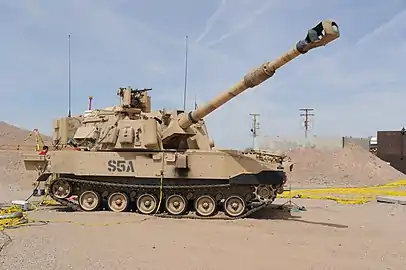 M109A7 155mm SPH being tested at Yuma Proving Ground, Arizona
M109A7 155mm SPH being tested at Yuma Proving Ground, Arizona
The newest M109 version for U.S. service is the M109A7, formerly known as the M109A6 Paladin Integrated Management (PIM). The M109A7 shares common chassis components with the Bradley Fighting Vehicle (BFV) such as the engine, transmission, and tracks. This creates commonality with other systems and maximizes cost-savings in production, parts inventory, and maintenance personnel. The M109A7's onboard power systems harness technologies originally developed for the Non-Line-of-Sight Cannon; the electric drive is faster than the previous hydraulic system, and the automatic rammer more consistently rams the round into the gun for consistent velocities and better accuracy. It features a 600-volt onboard power system to accommodate additional armor and future networking technologies as they become ready. The M109A7 can sustain a one-round per-minute rate of fire and a maximum rate of fire of four rounds per-minute.[30] Weighing 78,000 lb (35,000 kg), the M109A7 is 10,000 lb (4,500 kg) heavier than its predecessor, and it has the capacity to grow to 110,000 lb (50,000 kg). Even with the weight increase, the M109A7 can travel faster than previous versions at 38 mph (61 km/h) and is more maneuverable than a BFV.[31]
Prototypes of the vehicle underwent government testing in preparation for a Low-Rate Initial Production (LRIP) decision. The testing included RAM, mission and ballistic hull and turret testing. The M109A7 was slated to begin LRIP by 2013. The U.S. Army planned on procuring a fleet of 580 sets of M109A7 howitzers and M992A3 Field Artillery Ammunition Support Vehicles (FAASVs).[30]
In October 2013, the Defense Acquisition Board approved the decision to start M109A7 production. The FY 2014 budget called for $340.8 million in Paladin funding, which would be two dozen vehicle sets at $14.4 million per vehicle. The Army plans to buy 133 vehicles in 66 one-half vehicle sets starting in 2014, although one M109A7 howitzer and two supporting M992A3 ammunition carriers will be destroyed during tests. A Full-Rate Production (FRP) decision planned for February 2017.[32][33] On 31 October 2013, BAE received a $668 million contract to begin LRIP of the M109A7.[34] The first M109A6 and M992A2 vehicles were disassembled and reassembled to M109A7 and M992A3 standard as part of LRIP beginning in summer 2014.[35] LRIP deliveries began in April 2015.[36] The contract for FRP was signed in December 2017 with 48 vehicles slated for construction.[37] The Army plans to upgrade 689 Paladins to A7-standard.[38]

The Army is looking to increase the capabilities of the M109A7. By introducing the new XM1113 rocket-assisted projectile (RAP),[39] it can reach 40 km (25 mi) from the current 39-caliber barrel, and a planned barrel extension to 58-caliber can increase its range to 70 km (43 mi). An additional XM1113 improvement over the legacy RAP round is the replacement of the high explosive, TNT, with an insensitive munition that is less volatile and less prone to unplanned detonation. The Army is also working on an autoloader to increase sustained rate of fire to 6–10 rounds per minute.[39] Another part of the effort is the use of a new supercharged propellant to fire the shells, which required redesigning the howitzer to handle higher pressures.[40] These improvements are being developed under the Extended Range Cannon Artillery (ERCA) program, which upgrade the design so much it was re-designated the M1299; one battalion of vehicles is planned to begin a year-long operational assessment in 2023, and the autoloader is planned to be ready in 2025.[41]
Derivatives
M992
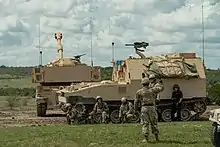
The M992 Field Artillery Ammunition Support Vehicle (FAASV) is built on the chassis of the M109. It replaced the M548. Unlike the M548, it is armored. This ammunition vehicle has no turret, but has a taller superstructure to store 93 rounds and an equivalent number of powders and primers.
This vehicle is fitted with a Halon fire suppression system and a weapons mount similar to that on the M109 turret, usually mounting a Mk 19 grenade launcher for local defense against infantry and light armored vehicles.
The vehicle also contains a 2-stroke diesel powered auxiliary power unit that can power all non-automotive energy requirements on the FAASV and on the M109.
K66
The K66 was a planned ammunition support vehicle for the K55. As a follow-up to the K55 program, Samsung Aerospace Industries prepared for licensing a local variant of the M992 with modifications such as NBC protection and the increase of ammunition storage capacity to 110 rounds, 116 packs of powders, and 132 primers.[42]
In 1987, Samsung Aerospace Industries completed against Daewoo Heavy Industries' ammunition support vehicle based on K200 APC. Daewoo Heavy Industries' vehicle was selected as the K66 but fell from the test evaluation. Eventually, the K66 project was cancelled in the mid-1990s as it expanded into a lawsuit.[18]
K77 FDCV (Fire Direction Center Vehicle)
The K77 FDCV is a command & control post vehicle variant based on the K55 platform.[43]
K56 ARV (Ammunition Resupply Vehicle)
The K56 ARV is a ammunition resupply vehicle based on the K55 platform.[44] Unlike the K10 ARV, the K56 can resupply both K55A1 and K9 Thunder. It has a 45.7% (4,197 out of 9,191 total parts) compatibility with K55A1.[45]
After 10 months of pilot experiment, the K56 program was authorized by DAPPC (Defense Acquisition Program Promotion Committee) on 16 February 2007.[46] On 2 May, DAPPC allocated 16 billion KRW for research and development for 2008 to 2010, with planning to produce 520 vehicles between 2011 to 2020.[47] On 26 June 2008, Samsung Techwin was selected as the main contractor for the project.[48] Later, the development completion schedule was delayed to 2011 while the total production amount was increased to 700 vehicles with 1.3 trillion KRW between 2012 to 2021.[49]
On 27 September 2010, the Board of Audit and Inspection claimed that the Army was biased during evaluation, demanding re-analyzing of the project due to inefficiency of the system. However, the Defense Acquisition Program Administration (DAPA) ignored the Board and continued with the project while the Army purposely delayed complying.[48] On 14 June 2011, the Ministry of Defense once again ordered a reexamination of the resupply vehicle.[50] Nevertheless, the DAPA requested a budget for the program instead, and the development was completed in October 2011.[51][45] On 25 July 2013, the DAPA announced the 1st batch production of the K56 between 2013 to 2015 for 65 billion KRW.[52]
In December 2015, Hanwha Techwin signed a contract with the DAPA for 2nd batch production. On 2 January 2018, Hanwha Land Systems announced 166.4 billion KRW contract with the DAPA for 3rd batch production and related products.[53] On 30 June 2020, Hanwha Defense announced 380.3 billion KRW contract with the DAPA for 4th batch production.[54] South Korea plans 5th batch production and achieving full operational capability by 2025. All K56s were delivered to the western front.[55]
Training systems
The US Army uses the Fire Support Combined Arms Tactical Trainer (FSCATT) in two versions for initial and sustainment training of the M109A6 and M109A5.[56] The system uses an actual surplus turret and a simulated ammunition system.
The Swiss Army uses a highly advanced KAWEST trainer from Van Halteren Metaal of the Netherlands.
The Dutch, Belgian, Thai, and Israeli Armies have various configurations of the Van Halteren Metaal M109 Howitzer Crew Trainer (HCT).
The US Army PEO STRI had a program called M109A7 Howitzer Crew Trainer (HCT). The plan was to procure 16 systems beginning in the 3rd Quarter of FY 20.[57]
Successors
The U.S. Army sought to replace the M109 with the XM2001 Crusader, initially part of the Armored Systems Modernization program. The program was canceled in 2002 amid criticism that the program was not in line with the Army's long-term plans for lighter armored brigades.[58] Funding was redirected to the Future Combat Systems Manned Ground Vehicles program, which produced the 18-ton XM1203 Non-Line-of-Sight Cannon as the program's lead effort. The Pentagon terminated the MGV program in 2009 due to concerns over its affordability.[59] The U.S. Army's M1299 howitzer was planned to be completed in 2021 and will undergo operational assessment in 2023.[60]
Operators

M109
M109A1
M109A2/A3
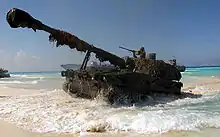
 Brazil: 40 A3 (former Belgian)
Brazil: 40 A3 (former Belgian) Greece: 84 A2, 50 A3GEA1, 223 A3GEA2[63]
Greece: 84 A2, 50 A3GEA1, 223 A3GEA2[63] Egypt: 400 A2
Egypt: 400 A2 Jordan: 356 A2/A2-90 (121 M109A2-90 purchased from Netherlands)
Jordan: 356 A2/A2-90 (121 M109A2-90 purchased from Netherlands) Lebanon: 12 A3
Lebanon: 12 A3 Morocco: 78 M109A2, 22 M109A3 and 40 M-109L47
Morocco: 78 M109A2, 22 M109A3 and 40 M-109L47 Pakistan: 785 A2 in service with the Pakistan Army. Being upgraded to M109A5 standard.[64][65]
Pakistan: 785 A2 in service with the Pakistan Army. Being upgraded to M109A5 standard.[64][65] Portugal: 6 A2 in 2022[66]
Portugal: 6 A2 in 2022[66] Saudi Arabia: 60 A2s are currently being upgraded to A5s (2010)
Saudi Arabia: 60 A2s are currently being upgraded to A5s (2010) Spain: 6 (Spanish Marines)[67]
Spain: 6 (Spanish Marines)[67] Tunisia: 19–20 A2 (former Belgian)
Tunisia: 19–20 A2 (former Belgian) Ukraine: 22 A3GN (donated by Norway)[68]
Ukraine: 22 A3GN (donated by Norway)[68]
M109A2/A5
M109A4
M109A5
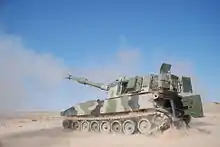
 Brazil: 96 A5/A5+[74][75] More 56 surplus U.S. Army, to be upgraded to M109A5+, contract awarded to BAE Systems.[76][77][78]
Brazil: 96 A5/A5+[74][75] More 56 surplus U.S. Army, to be upgraded to M109A5+, contract awarded to BAE Systems.[76][77][78] Chile: 48 (24 from Switzerland, upgraded to M-109 KAWEST,[62][15] 12 A3 and 12 A5+ Upgrade to similar Paladin configuration[79])
Chile: 48 (24 from Switzerland, upgraded to M-109 KAWEST,[62][15] 12 A3 and 12 A5+ Upgrade to similar Paladin configuration[79]) Egypt: 201
Egypt: 201 Saudi Arabia: 36
Saudi Arabia: 36 Iraq: 90[80]
Iraq: 90[80] Israel: 600
Israel: 600 Pakistan: ca. 115 in 2022
Pakistan: ca. 115 in 2022 Portugal : 18 since 2002 (Portuguese Army). 6 of these vehicles were M109A2/A3 upgraded to A5 variant. This variant replaced the previous 6 M109A2 operated by the Portuguese Army.[81]
Portugal : 18 since 2002 (Portuguese Army). 6 of these vehicles were M109A2/A3 upgraded to A5 variant. This variant replaced the previous 6 M109A2 operated by the Portuguese Army.[81] Thailand: 20
Thailand: 20 Greece: 12
Greece: 12 Spain: 96 (Spanish Army)[82]
Spain: 96 (Spanish Army)[82] Morocco: 70[83]
Morocco: 70[83] Lebanon: 74 TBD
Lebanon: 74 TBD Republic of China (Taiwan): 28
Republic of China (Taiwan): 28
M109A6 Paladin
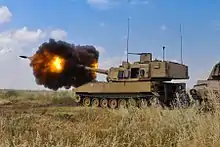
 United States: ca. 514 in service + ca. 850 in storage in 2022[84]
United States: ca. 514 in service + ca. 850 in storage in 2022[84] Saudi Arabia: 177 ordered in April 2018.[85]
Saudi Arabia: 177 ordered in April 2018.[85] Republic of China (Taiwan) (Cancelled): >100 planned in 2019, 40 approved by U.S. State Department in August 2021.[86] However, the US has since cancelled the order, possibly in the wake of ramping up support for Ukraine, forcing Taiwan to consider alternative options.[87]
Republic of China (Taiwan) (Cancelled): >100 planned in 2019, 40 approved by U.S. State Department in August 2021.[86] However, the US has since cancelled the order, possibly in the wake of ramping up support for Ukraine, forcing Taiwan to consider alternative options.[87]
M109A7
 United States: 48 with a further 180 contracted options[88]
United States: 48 with a further 180 contracted options[88]
K55/K55A1
 South Korea: 1,180 K55s were produced by Samsung Aerospace Industries between 1985 to 1996. All vehicles are undergoing upgrade to K55A1 since 2010. Operated by the Army and the Marine Corps.
South Korea: 1,180 K55s were produced by Samsung Aerospace Industries between 1985 to 1996. All vehicles are undergoing upgrade to K55A1 since 2010. Operated by the Army and the Marine Corps.
M109A2/A3
.svg.png.webp) Belgium: 167 A2, of which 64 were upgraded to the -A4BE standard, 31 sold to Brazil (1999–2001), 43 sold to Morocco (2008), the remainder being decommissioned
Belgium: 167 A2, of which 64 were upgraded to the -A4BE standard, 31 sold to Brazil (1999–2001), 43 sold to Morocco (2008), the remainder being decommissioned Denmark: 2–6 (upgraded to M109 A3DK, used to be 76)[89]
Denmark: 2–6 (upgraded to M109 A3DK, used to be 76)[89] Germany: 570 A3GE A1/A2, phased out by 1 July 2007 and replaced by the PzH 2000
Germany: 570 A3GE A1/A2, phased out by 1 July 2007 and replaced by the PzH 2000 Italy: 221 M109L (M109 modernized to A3 equivalent with Italian-made 155 mm/39 calibre barrels),[90] replaced by PzH 2000
Italy: 221 M109L (M109 modernized to A3 equivalent with Italian-made 155 mm/39 calibre barrels),[90] replaced by PzH 2000 Kuwait: Unknown when entered service or when withdrawn
Kuwait: Unknown when entered service or when withdrawn Netherlands: 126 as of 1998, replaced by the PzH 2000, 5 sold to Austria (1997), 87 to United Arab Emirates (1997), 121 to Jordan (2011–2012))
Netherlands: 126 as of 1998, replaced by the PzH 2000, 5 sold to Austria (1997), 87 to United Arab Emirates (1997), 121 to Jordan (2011–2012)) Norway: 33 in storage after donation of 22 to Ukraine in 2022.[17] 55 in storage in 2021.[91] Inventory of 14 M109A3GNM + 42 M109A3GN in 2019.
Norway: 33 in storage after donation of 22 to Ukraine in 2022.[17] 55 in storage in 2021.[91] Inventory of 14 M109A3GNM + 42 M109A3GN in 2019. Portugal: 6 A2 since 1981 (Portuguese Army). Currently retired from active service and replaced by 18 M109A5 in 2002.[92]
Portugal: 6 A2 since 1981 (Portuguese Army). Currently retired from active service and replaced by 18 M109A5 in 2002.[92] United Kingdom: 140+ entered service in 1965, upgraded to -A1 and -A2 standards, 83 sold to Austria in 1994 (51 A2, 32 A3)
United Kingdom: 140+ entered service in 1965, upgraded to -A1 and -A2 standards, 83 sold to Austria in 1994 (51 A2, 32 A3)
M109A4
.svg.png.webp) Belgium: 64 A4BE of which 36 A4BE sold to Indonesia (2017–2018) and unknown number (at least 20 units) bought by the UK for Ukraine
Belgium: 64 A4BE of which 36 A4BE sold to Indonesia (2017–2018) and unknown number (at least 20 units) bought by the UK for Ukraine.svg.png.webp) Canada: 76 A4B+.[93] Used by the Canadian Forces from 1967 until 2005, when they were phased out. All the vehicles had been modernized to the M109A4B+ SPH standard in the 1980s. They were primarily used by the 4 Canadian Mechanized Brigade Group in Germany.[94]
Canada: 76 A4B+.[93] Used by the Canadian Forces from 1967 until 2005, when they were phased out. All the vehicles had been modernized to the M109A4B+ SPH standard in the 1980s. They were primarily used by the 4 Canadian Mechanized Brigade Group in Germany.[94]
International equivalents
- 2S3 Akatsiya – Soviet/Russian equivalent
- 2S19 Msta – Soviet/Russian equivalent
- 2S35 Koalitsiya-SV – Russian equivalent
- AHS Krab - Polish equivalent
- PzH 2000 – German equivalent
- GCT 155mm – French equivalent
- AS-90 – British equivalent
- K9 Thunder – South Korean howitzer developed by Samsung Techwin
- Palmaria - Italian equivalent built for export
- PLZ-05 – Chinese equivalent
- Type 75/Type 99 – Japanese equivalent
- Sholef - Israeli equivalent (prototype)
- Bandkanon 1 – armored self-propelled L/50 155 mm gun for the Swedish Army from 1967 to 2003
- 152mm SpGH DANA - Army of the Slovak Republic
See also
- List of artillery
- List of land vehicles of the U.S. Armed Forces
- M107 standard 155mm High Explosive (HE) projectile
- M549 HE Rocket Assisted (HERA) projectile
- M864 Dual-Purpose Improved Conventional Munition (DPICM)
- M795, a more lethal, longer range version of the M107 HE projectile
Notes
- "Battle of Mosul 2016– French Artillery Fire on ISIS / M109 Paladins Fire Support". YouTube. Archived from the original on 11 December 2021.
- Quitney, Jeff (14 March 2012). "M109 155mm Howitzer Self-Propelled from "Weapons of the Field Artillery" 1965 US Army" – via YouTube.
{{cite web}}: CS1 maint: url-status (link) - "Excalibur Projectile". Raytheon missiles & defense.
- "Paladin 155mm Self-Propelled Howitzer". Army Technology. Archived from the original on 22 December 2010. Retrieved 23 December 2010.
- [첨단국가의 초석, 방위산업] 자주포 개발사 - 전설의 시작 K-55, retrieved 6 August 2022
- "복면지왕, 북한의 양면전술". h21.hani.co.kr (in Korean). Retrieved 17 February 2022.
- These Are the New Weapons the Pentagon Chief Wants for Tomorrow’s Wars Archived 3 February 2016 at the Wayback Machine, Defense one, 2 February 2016
- 'Micro' Drones, 'Arsenal' Plane, Railguns Funded in New Defense Budget Archived 2016-10-08 at the Wayback Machine, Military.com, 2 February 2016.
- Robot Boats, Smart Guns & Super B-52s: Carter’s Strategic Capabilities Office Archived 9 February 2016 at the Wayback Machine, Breaking defense, 5 February 2016
- ABMS Demo Proves AI Chops For C2. Breaking Defense. 3 September 2020.
- ‘Smart’ Bullet Downs Cruise Missile in 2nd ABMS Test. Air Force Magazine. 4 September 2020.
- Lathrop, R. (5 February 2005). M109 155mm Self-Propelled Howitzer 1960–2005. Osprey Publishing. p. 15. ISBN 9781841766317.
- "M109 155mm SP Howitzer". Archived from the original on 7 May 2016. Retrieved 9 May 2016.
- "M109". ruag.com. Archived from the original on 9 July 2018. Retrieved 9 May 2018.
- "Chile Requests a Mechanized Artillery Battalion". Defense Industry Daily. 6 October 2011. Archived from the original on 9 May 2018. Retrieved 9 May 2018.
- "Denne gjør Hæren sterkere". Forsvaret (in Norwegian). 4 September 2020. Retrieved 4 June 2022.
- "Norway has donated M109 to Ukraine". regjeringen.no (Norwegian Government). 8 June 2022.
- "[김대영의 무기 인사이드] 우리 군에서 영구 결번된 비운의 국산장갑차 'K66'". 나우뉴스 (in Korean). Retrieved 8 August 2022.
- 李敦琯기자. "한반도 전쟁발발시 美전투력 즉각 증강". n.news.naver.com (in Korean). Retrieved 8 August 2022.
- "국산 1백55mm 자주포 대량수출 전망". n.news.naver.com (in Korean). Retrieved 8 August 2022.
- "1백55mm 국산자주포 수출 무산". n.news.naver.com (in Korean). Retrieved 8 August 2022.
- 朴成雨기자. "포병학교 자주포 조종 시뮬레이터 개발". n.news.naver.com (in Korean). Retrieved 8 August 2022.
- 기자, 김남권. "국방위, 내년 국방예산 7천146억원 증액 의결". n.news.naver.com (in Korean). Retrieved 12 August 2022.
- 국방일보. "K55A1 자주포". 국방일보. Retrieved 10 August 2022.
- 국방일보. "생존·기동·효율성 완벽 호흡…'환상의 짝꿍' 자랑". 국방일보. Retrieved 14 August 2022.
- 똑똑하게 다시 태어났다 K55A1 자주포, retrieved 12 August 2022
- "TZEN APU". www.tzen.co.kr. Retrieved 12 August 2022.
- "방위산업용 부품". (주)모트롤 (in Korean). Retrieved 19 August 2022.
- 국방일보. "전투장비 100% 성능발휘 보장". 국방일보. Retrieved 10 August 2022.
- "Army developing new self-propelled howitzer". 1 September 2011. Archived from the original on 11 October 2012. Retrieved 5 September 2011.
- US Army Breaking Out the Big New Guns – Defensenews.com, 27 April 2014
- BAE Systems could obtain new contract from U.S. Army for M109A7 155m self-propelled howitzer Archived 29 October 2013 at the Wayback Machine – Armyrecognition.com, 26 October 2013
- New Paladin to Enter Low-Rate Production – Defensenews.com, 21 October 2013
- BAE Systems Awarded Contract to Begin Production of Paladin Integrated Management Archived 2 November 2013 at the Wayback Machine – BAE press release, 31 October 2013
- Self-propelled howitzer M109A7 and M992A3 carrier ammunition enter in service with U.S. Army Archived 16 July 2015 at the Wayback Machine – Armyrecognition.com, 20 May 2014
- Army accepts delivery of first M109A7 Self-Propelled Howitzer system Archived 10 April 2015 at the Wayback Machine – Army.mil, 9 April 2015
- "U.S. Army contracts for full-rate production on M109A7 weapon vehicle – Military Embedded Systems". mil-embedded.com. Archived from the original on 27 December 2017. Retrieved 28 December 2017.
- Plan would double artillery upgrades in Army arsenal over the next five years. Army Times. 22 March 2019.
- US Army to demo precision strike, hypersonics, ramjet capabilities in just a few years. Defense News. 20 March 2018.
- New Army Cannon Doubles Range; Ramjet Ammo May Be Next. Breaking Defense. 6 March 2020.
- Army Outlines Ambitious Schedule For Robots, Armor. Breaking Defense. 19 March 2021.
- "K66". Archived from the original on 30 April 2011.
- "Hanwha Defense K77". www.hanwha-defense.co.kr. Retrieved 8 August 2022.
- "한화디펜스 K56". www.hanwha-defense.co.kr (in Korean). Retrieved 8 August 2022.
- "K55A1자주포의 단짝 K56탄약운반장갑차 실전 배치". www.korea.kr (in Korean). Retrieved 19 August 2022.
- "제13회 방위사업추진위원회 개최 결과". n.news.naver.com (in Korean). Retrieved 12 August 2022.
- "K-55용 탄약운반 장갑차 3년내 개발". n.news.naver.com (in Korean). Retrieved 19 August 2022.
- 송한진. "李 국방, 제28회 방위사업추진위원회 주재". n.news.naver.com (in Korean). Retrieved 19 August 2022.
- "자주포 탄약운반장갑차 개발, 엉터리 조사 토대로… 軍, 1조2000억원대 사업 강행". 국민일보 (in Korean). 27 September 2010. Retrieved 19 August 2022.
- "軍 중기 전력 13개 사업 재검토". 국민일보 (in Korean). 14 June 2011. Retrieved 19 August 2022.
- 홍장기. "탱크 여러대 잡는 '확산탄' 2014년 도입". n.news.naver.com (in Korean). Retrieved 19 August 2022.
- "제 68회 방위사업추진위원회 개최결과". www.korea.kr (in Korean). Retrieved 10 August 2022.
- NEWSIS (2 January 2018). "한화테크윈 종속사, 방위청과 4729억원 규모 공급 계약 체결". newsis (in Korean). Retrieved 22 August 2022.
- 머니투데이 (30 June 2020). "한화디펜스, 3803억원 규모 K56 장갑차 4차 양산 계약". 머니투데이 (in Korean). Retrieved 22 August 2022.
- 국방일보. "K56 탄약운반장갑차". 국방일보. Retrieved 22 August 2022.
- "Fire Support Combined Arms Tactical Trainer (FS-CATT)". US Army. Archived from the original on 9 November 2011. Retrieved 10 December 2011.
- "Howitzer Crew Trainer (HCT)- Sources Sought - W900KK-19-C-HCT1 - Federal Business Opportunities: Opportunities". Archived from the original on 22 January 2019. Retrieved 21 January 2019.
- Shanker, Thom (30 May 2002). "President Formally Seeks Halt to Crusader Artillery Program". The New York Times. Retrieved 5 August 2018.
- Censer, Marjorie (14 December 2009). "Promising thorough vehicle review ...: DOD Acquisition Chief Formally Terminates Army's NLOS Cannon". Inside the Army. Vol. 21, no. 49. Inside Washington Publishers. JSTOR 24831487. Retrieved 18 February 2022.
- Vandiver, John. "New Army cannon hits target 43 miles away in test". Stars and Stripes.
{{cite web}}: CS1 maint: url-status (link) - "Panzerhaubitze M 109 KAWEST". He. 18 December 2009. Archived from the original on 11 May 2011. Retrieved 23 December 2010.
- "RUAG Land Systems 155 mm M109 upgrade (Switzerland)". Armour & artillery. Jane's.
- ""Κοσμογονία" για το πυροβολικό του ΕΣ: Αγοράζονται 36 PzH-2000 και 169 μεταχειρισμένα Μ109Α3GEA2" (in Greek). Defence net. 13 May 2009. Archived from the original on 12 May 2011. Retrieved 23 December 2010.
- Mehta, Sureesh (2008). South Asia Defence And Strategic Year Book. Pentagon Press. p. 329. ISBN 978-81-8274-320-5.
- "Cold War Bargains Still to Be Had". Strategy page. 22 February 2010. Archived from the original on 29 October 2013. Retrieved 6 May 2013.
- Military Balance 2022
- "Obus Autopropulsado ATP M-109 A2" (in Spanish). Infantería de Marina – Armada Española. Archived from the original on 26 April 2011. Retrieved 23 December 2010.
- "Norway has donated M109 to Ukraine". Norwegian Government. 8 June 2022.
- "Министр обороны подписал договор о покупке б/у гаубиц у Австрии". TV net (in Russian). 27 May 2017. Retrieved 30 May 2017.
- "Video: Bruņotie spēki sāk apgūt jaunās haubices" [The Armed Forces start to master the new howitzers]. LSM (in Latvian). 9 October 2017. Archived from the original on 16 March 2018. Retrieved 15 March 2018.
- "Latvija noslēgusi līgumu ar Austriju par vēl 18 pašgājējhaubiču iegādi". TV net. 18 May 2021. Retrieved 18 May 2021.
- "armyrecognition.com - Six M109A5Oe self-propelled howitzers sent to Ukraine by Latvia already in action".
{{cite web}}: CS1 maint: url-status (link) - "NATO weapons boost for Ukraine".
- "Exército receberá mais sessenta M109 A5 dos EUA". Defesa aérea & naval (in Portuguese). 30 June 2017. Archived from the original on 2 July 2017. Retrieved 1 July 2017.
- "Regimento Mallet recebe M109 A5 + BR". Forte (in Portuguese). 15 October 2019.
- Brazil; Army plans to purchase US Army surplus 155mm artillery pieces Archived 2014-12-05 at the Wayback Machine, Dmilt, 13 March 2013
- Wasserbly, Daniel (20 September 2016). "BAE Systems awarded long-stalled Brazilian howitzer modernisation deal". IHS Jane's 360. Washington, DC. Retrieved 20 September 2016.
- Barreira, Victor (18 July 2017). "Brazilian Army receiving 60 more US M109A5 howitzers". IHS Jane's 360. Archived from the original on 18 July 2017. Retrieved 18 July 2017.
- "International" (news release). BAE Systems. Archived from the original on 7 October 2011. Retrieved 5 October 2011.
- The Military Balance. International Institute for Strategic Studies. 1980. ISBN 0-85368-197-X.
- "M-109 A5 – FMC-United Defense / BAE Systems / Portugal". Área militar. Archived from the original on 23 November 2016. Retrieved 8 May 2011.
- "ATP 155/39 M-109 A5E" (in Spanish). Ejército de tierra. 1 December 2001. Archived from the original on 12 November 2010. Retrieved 23 December 2010.
- Binnie, Jeremy (24 November 2016). "Morocco takes delivery of M109A5 howitzers". IHS Jane's 360. Retrieved 28 November 2016.
- Military Balance 2022
- "The Kingdom of Saudi Arabia – 155mm M109A6 Paladin Medium Self-Propelled Howitzer System". Defense Security Cooperation Agency. 5 April 2018. Archived from the original on 7 April 2018. Retrieved 7 April 2018.
- "U.S. approves potential sale of howitzers to Taiwan – Pentagon". Reuters. 4 August 2021. Retrieved 5 August 2021.
- "Taiwan considers alternative weapons after US informs howitzer delay". Al Arabiya. 2 May 2022. Retrieved 3 May 2022.
- Judson, Jen (21 December 2017). "US Army awards BAE contract to build full-rate production howitzers". Defense news.
- Stort set intet fungerende dansk artilleri tilbage Ingeniøren, October 2015. Quote: "Of the 6 operative, are only 2–4 available"
- "Oto Melara 155 mm M109L self-propelled howitzer (Italy)". Armour and Artillery. Jane's. 9 February 2010. Archived from the original on 12 December 2009. Retrieved 23 December 2010.
- Fremover, Bekrefter norsk artilleri til Ukraina (2022-05-24)
- "M-109 A2/A3 – FMC-United Defense / BAE Systems / Portugal". Área militar. Archived from the original on 23 November 2016. Retrieved 8 May 2011.
- "Transformation". Structure (fact sheet). The Canadian Army. 2006. Archived from the original on 7 June 2008.
- Lathrop, R.; Zaloga, Steven J. (2005). M109 155mm Self-Propelled Howitzer 1960–2005. Bloomsbury USA. p. 48. ISBN 978-1-84176-631-7.